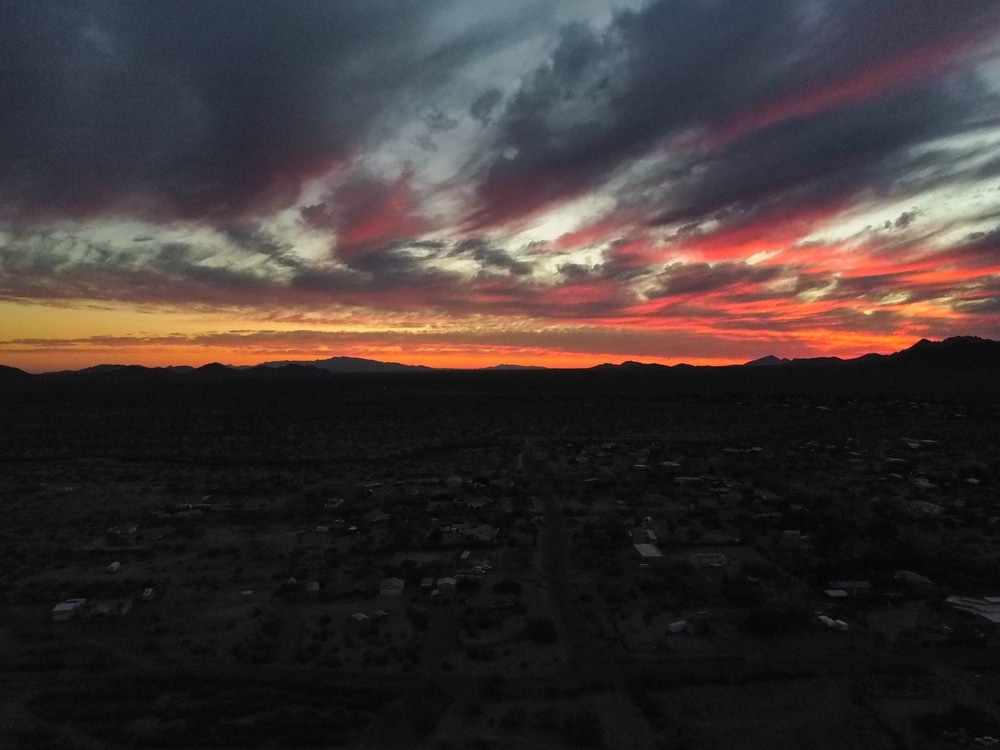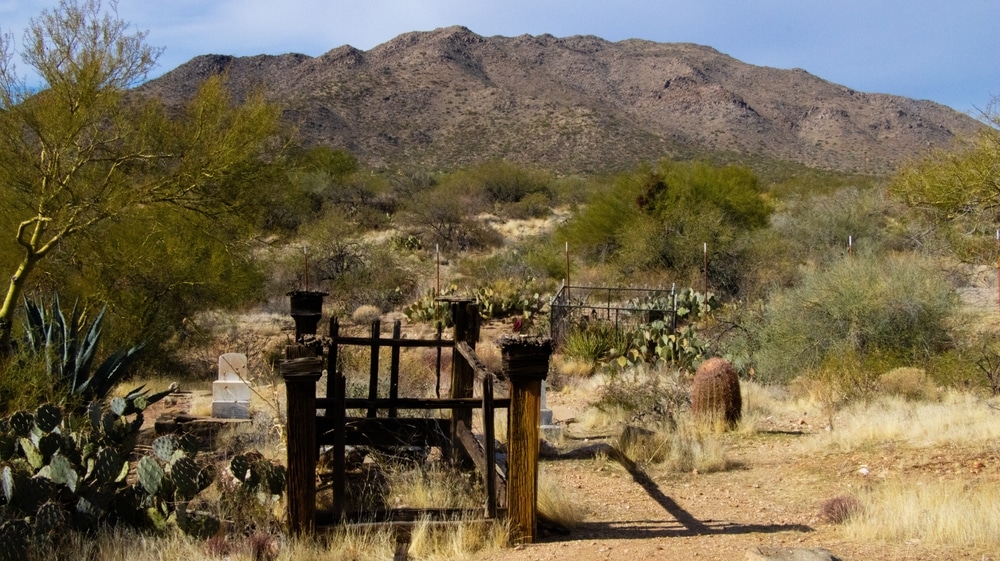The sun-bleached buildings of Congress, Arizona stand in quiet defiance against the passage of time, scattered across a landscape where the Sonoran Desert meets the rugged foothills of the Date Creek Mountains. What remains today—a collection of weathered structures, abandoned mining equipment, and two distinct cemeteries—tells only part of the story of this once-vibrant mining community. The whispers of the past can still be heard in the creaking of corrugated metal roofs and the distant echo of a train whistle that no longer sounds. Here, amid the ocotillo and prickly pear, lies a forgotten chapter of Arizona’s pioneering spirit, where dreams of fortune were born, flourished briefly, and ultimately faded into the desert air.

The Congress Pioneer Cemetery offers a moving glimpse into the town’s mining-era past. Many gravestones date back to the late 1800s and early 1900s, bearing the names of early miners, settlers, and families who braved the frontier. The cemetery, located on a small hill, provides quiet reflection and panoramic views of the desert.
Once one of Arizona’s richest gold mines, the Congress Mine drew prospectors and fortune-seekers from across the country. While most of the mine infrastructure is gone or located on private property, you can still view tailings piles, historic markers, and remnants of machinery from a distance. The mine played a major role in Arizona’s early economy, and its legacy remains a source of local pride.
Congress is part of the Arizona Ghost Town Trail, which also includes nearby towns like Gleeson, Courtland, and Constellation. You can explore this scenic loop by vehicle, visiting sites that showcase Arizona’s boom-and-bust mining history. The loop offers a mixture of ruins, desert vistas, and stories of life on the frontier.

Heading north from Congress on State Route 89, you’ll ascend the Yarnell Hill, a winding and scenic climb with sweeping views of the desert below. This route is popular among photographers, motorcyclists, and road trippers, leading to the small town of Yarnell and eventually Prescott.

The Weaver Mountains, located west of Congress, offer opportunities for hiking, rockhounding, and desert exploration. Trails and dirt roads wind through rugged hills, often revealing colorful rocks, wildflowers in spring, and the occasional abandoned mining shaft or camp.

The area around Congress is well-known among rockhounds and geology enthusiasts for its quartz, chalcedony, agates, and gold specimens. Exploring dry washes and old claims may yield interesting finds—just be sure to avoid active claims and always follow local regulations.

Though small, Congress features a few local businesses like the Congress Mercantile, a cozy country store where visitors can pick up snacks, gifts, and local goods. There are also a handful of eateries and diners offering home-style meals and warm hospitality.
Congress’s remote location and minimal light pollution make it a fantastic place for stargazing. On clear nights, the sky reveals the Milky Way in full splendor, and constellations are easily visible to the naked eye. It’s an ideal location for night photography or simply enjoying the stillness of the desert.
Among the most notable individuals buried in the Pioneer Cemetery is William “Billy” Miller, whose simple grave marker bears the inscription “Killed defending what was his, 1897.” Miller, a shift supervisor at the Congress Mine, died in a gunfight with claim jumpers attempting to stake illegal claims on mine property. Local legend holds that Miller single-handedly confronted three armed men, managing to wound two before succumbing to his injuries. His funeral was reportedly attended by nearly every resident of Congress, and the mine ceased operations for a full day in his honor.
The Community Cemetery contains the elaborate family plot of the Martinez family, whose patriarch, Emmanuel Martinez, established the Congress Mercantile Company in 1895. The store became the commercial center of Congress, selling everything from mining supplies to household goods. The Martinez family monuments—a central obelisk surrounded by six smaller headstones—reflect their prominence in the community. Family records indicate that Martinez extended credit to miners during difficult times and was known for his generosity during the typhoid outbreak of 1902, providing food and supplies to affected families.
Cemetery records also tell the story of Dr. Eleanor Cartwright, one of Arizona Territory’s few female physicians, who arrived in Congress in 1901 to serve the growing community. Her grave in the Community Cemetery bears the inscription “She healed many and was loved by all.” According to accounts in the Congress Miner, Dr. Cartwright established a small infirmary near the mine entrance where she treated injuries and illnesses. She remained in Congress until 1912, well into the town’s decline, before relocating to Prescott where she lived until her death in 1927. Her body was returned to Congress for burial at her request.
The hardships of mining life are personified in the story of the Reynolds family, whose plot in the Pioneer Cemetery contains four graves—a father and three young sons, all lost within a two-year period. Thomas Reynolds, a miner from Cornwall, England, died in a mining accident in 1896, leaving his wife to support their children. Census records indicate she took in laundry from the mine’s bachelor employees, but typhoid claimed her three sons in quick succession during the 1902 outbreak. Local accounts suggest she left Congress shortly thereafter, though no record exists of her ultimate fate.

| Category | Details |
|---|---|
| Name | Congress, Arizona |
| Type | Living town with adjacent historic ghost town site |
| County | Yavapai County |
| Founded | Circa 1884 (mining camp origins); town grew in 1890s |
| Status | Modern residential area; original townsite is a ghost town |
| Population (Historic) | ~500–2,000 during peak mining years |
| Population (Current) | ~1,700 (Congress CDP as of 2020 census) |
| Historical Significance | Site of the Congress Mine, one of Arizona’s most productive gold mines |
| Primary Industry (Historic) | Gold mining; produced over $8 million in gold by the early 1900s |
| Post Office | Established in 1891; still in operation |
| Decline Factors | Closure of Congress Mine in the 1930s, decline of rail line |
| Remnants Today | Mine shafts, stone ruins, mill foundations, miner’s cabins, cemetery |
| Nearby Towns | Wickenburg (~15 miles south); Yarnell and Prescott also nearby |
| Geographic Setting | Foothills of the Date Creek Mountains, along State Route 89 |
| Elevation | Approx. 3,050 feet (930 meters) |
| Climate | High desert – mild winters, hot summers |
| Access | Easy access via US Highway 93 and AZ-89 |
| Best For | Ghost town explorers, history buffs, rockhounds, winter residents |
Congress was born of gold, like many of Arizona’s ghost towns. In 1884, prospector Dennis May discovered gold-bearing quartz in the area, but it was the Congress Mine, established in 1887 by diamond driller “Diamond Joe” Reynolds, that transformed the remote location into a bustling settlement. The Congress Mine would eventually produce over $8 million worth of gold (approximately $240 million in today’s currency), becoming one of Arizona’s richest gold producers.
The town’s fortunes rose dramatically in 1893 when the Santa Fe, Prescott and Phoenix Railway extended a spur line to Congress, connecting this remote mining operation to the broader transportation network. By the early 1900s, Congress reached its peak population, with approximately 500 residents working in the mines or supporting the community through various businesses and services.
Congress existed in the context of Arizona’s territorial period and early statehood. When the mine was established, Arizona was still 25 years away from achieving statehood, and the territory represented the quintessential “Wild West” that captivated the American imagination. The town’s development paralleled Arizona’s transition from a rugged frontier to an emerging modern state.
Today, Congress exists in two distinct parts—the original mining settlement, much of which has been reclaimed by the desert, and the “new” Congress, a small community along Highway 89 that serves as a quiet reminder of what once was. In Old Congress, visitors can still find the weathered remnants of the Congress Mine itself, including partial foundations of the stamp mill where gold ore was crushed, rusting mining equipment, and the stone ruins of several mine buildings.
The most prominent remaining structure is the old Congress store, its adobe walls still standing despite a century of harsh desert conditions. Nearby, several wooden cabins that once housed miners remain in various states of decay, their windows empty and rooflines sagging. The former assay office, where ore samples were tested for gold content, stands as a testament to the scientific precision that underpinned the mining operation.
Evidence of the town’s former infrastructure is visible in the remnants of the water system—stone cisterns and segments of piping—that once supplied this desert community. The grid-like pattern of former streets can still be discerned in some areas, though desert vegetation has reclaimed much of the town’s original footprint.
Congress is relatively accessible to visitors interested in Arizona history. Located approximately 70 miles northwest of Phoenix, the ghost town can be reached via Highway 89. While most of the ghost town sits on private property, several structures are visible from public roads, and local businesses in the new settlement of Congress Junction occasionally offer guided historical tours with property owner permission.
Perched on a gentle slope overlooking the former townsite, the Congress Pioneer Cemetery serves as a poignant reminder of the hardships faced by early settlers. Established in 1889, shortly after the mine began operations, this burial ground contains approximately 50 marked graves, though local historians believe many more unmarked burials exist within its boundaries.
The cemetery is enclosed by a simple wire fence, with a metal gate bearing a small plaque that identifies it as the final resting place of Congress’s earliest inhabitants. Inside, weathered headstones of limestone, marble, and wood stand in irregular rows, many tilting with age and the shifting desert soil. The oldest grave dates to 1890, marking the burial of a miner killed in an early accident at the Congress Mine.
Several grave markers tell the story of the dangers inherent in mining life—epitaphs mentioning “taken by cave-in” or “lost to mine fire” appear with sobering frequency. A cluster of graves from 1899 commemorates five miners lost in a single catastrophic accident when a support beam collapsed, providing a stark reminder of the price paid for the gold that built the town.
The Pioneer Cemetery also reveals patterns of disease that swept through the community, with several graves from 1902 indicating a typhoid outbreak that claimed multiple lives within a few weeks. Children’s graves are numerous, underscoring the high infant mortality rates common in remote mining towns before modern medicine.
The cemetery is maintained sporadically by volunteer efforts and descendants of those buried there, though the harsh desert climate continues to erode many of the markers. The Yavapai County Historical Society occasionally conducts preservation projects to document and stabilize the remaining gravestones.
A mile from the Pioneer Cemetery lies the larger Congress Community Cemetery, established around 1905 when the town had grown substantially. Unlike its predecessor, this burial ground reflects a more established community with greater socioeconomic diversity and more elaborate memorial practices.
This cemetery contains approximately 120 marked graves arranged in family plots, suggesting the evolution of Congress from a transient mining camp to a more settled community. Graves here represent a broader demographic range, including not only miners but also railroad workers, merchants, and their families. The cemetery includes sections that appear to have been designated for different ethnic groups, with one area containing markers with Hispanic surnames and another with stones bearing Chinese characters, reflecting the diverse workforce that supported the mining operations.
Burial practices evolved visibly between the two cemeteries—while the Pioneer Cemetery features primarily simple markers with basic information, the Community Cemetery showcases more elaborate monuments, including obelisks, carved angels, and family plots surrounded by wrought iron fencing. Several graves display Masonic symbols, indicating the presence of fraternal organizations that were vital to community cohesion in many mining towns.
Unlike the Pioneer Cemetery, which fell into disuse as the original settlement declined, the Community Cemetery continued to receive burials well into the 1940s, long after the mines had closed, indicating the persistence of community ties even as economic opportunity faded.
Congress was served primarily by one newspaper, the Congress Miner, established in 1895 by editor Samuel P. Harding, who saw opportunity in the growing mining community. Published weekly, the paper reached a peak circulation of approximately 300 copies during the town’s heyday.
The Congress Miner maintained a decidedly pro-business editorial stance, frequently advocating for mining interests and railroad expansion. Editor Harding was known for his boosterism, regularly publishing glowing accounts of the town’s prospects and opportunities for investment. The newspaper office, a modest wooden structure with a hand-cranked printing press, stood on Main Street adjacent to the Congress Mercantile Company store.
The newspaper documented the rhythm of community life—from mining successes and accidents to social gatherings, church events, and school activities. Special editions celebrated the arrival of the railroad in 1893 and the opening of the new schoolhouse in 1897. The paper also served as a chronicle of tragedy, with detailed accounts of mining disasters, including the devastating 1899 cave-in that claimed five lives.
When labor disputes arose at the mine in 1903, the Congress Miner took a firmly anti-union position, reflecting the owner’s alignment with management interests. This stance alienated many working-class readers and led to a brief competing publication, the Miner’s Voice, though this rival paper lasted only seven months before folding.
The Congress Miner ceased publication in 1911, coinciding with the initial decline in mining operations. The printing press was sold to a newspaper in Wickenburg, and the newspaper’s complete archives were reportedly destroyed in a fire in 1917, though scattered issues survive in the collections of the Sharlot Hall Museum in Prescott and the Arizona Historical Society.
The arrival of the Santa Fe, Prescott and Phoenix Railway in 1893 transformed Congress from an isolated mining camp to a connected community. The railroad built a spur line specifically to service the profitable Congress Mine, with a small depot constructed near the mine operations.
The Congress depot was a simple wooden structure with a telegraph office, ticket counter, and small waiting area. Adjacent to the depot stood a water tower that served the steam locomotives and a small warehouse for freight shipments. The most substantial railroad structure was the loading platform where ore from the Congress Mine was transferred to railcars for shipment to processing facilities.
Train service to Congress initially ran three times weekly, bringing mail, supplies, and new arrivals while carrying out gold ore and occasional passengers. By 1900, daily service connected Congress to both Phoenix and Prescott, allowing residents access to larger markets and greater amenities than their remote location would otherwise permit.
The railroad employed approximately 15 people in Congress, including station agents, telegraphers, and maintenance workers. These railroad employees formed a distinct social group within the community, often living in company-provided housing near the depot.
Rail service proved crucial to the mine’s profitability, as it dramatically reduced transportation costs compared to the earlier wagon routes. Before the railroad, ore had to be hauled by mule teams over rough terrain, limiting production capacity and cutting into profits.
The decline of rail service paralleled the mine’s fortunes. When the Congress Mine reduced operations in 1910, train service was cut to three times weekly. By 1917, when the mine temporarily closed, only a weekly freight train served the community. The spur line was formally abandoned in 1927 after years of minimal use, and the tracks were eventually salvaged for scrap metal during World War II.
Today, little remains of the railroad infrastructure beyond the stone foundations of the depot and scattered railroad ties. The former rail bed, however, can still be traced through the landscape as a level grade cutting through the otherwise rugged terrain.
The decline of Congress began gradually around 1910 when the richest veins of gold in the Congress Mine showed signs of depletion. The mine briefly closed in 1917 but reopened under new ownership in 1918 with modern equipment. This revival proved short-lived, as the quality of ore continued to deteriorate, and the mine permanently ceased operations in 1938.
The cessation of newspaper publication in 1911 marked an early sign of community contraction. Without the Congress Miner to promote local interests and maintain communication, community cohesion began to erode. The reduction and ultimate termination of railroad service further isolated the town, making it increasingly difficult for residents to maintain connections with larger economic centers.
Unlike some mining towns that experienced catastrophic abandonment, Congress underwent a gradual exodus. Census records indicate that the population decreased from approximately 500 in 1905 to fewer than 100 by 1940. Many miners relocated to more promising operations in Jerome or Bisbee, while merchants and service providers followed the shifting population centers.
A small community persisted along the highway after the original townsite was largely abandoned, eventually becoming the modern settlement of Congress Junction. The original Congress eventually stood empty, with the last family reportedly leaving the old townsite in 1962 when maintaining water access became untenable.
Interestingly, both cemeteries continued to receive occasional burials even after the town’s economic basis had disappeared. The Community Cemetery recorded interments as late as 1968, suggesting that former residents maintained strong emotional connections to the community even decades after leaving. These later burials were primarily former residents who had expressed wishes to be buried alongside family members in the town where they had spent their most prosperous years.
Congress represents a well-preserved example of the mining communities that drove Arizona’s economic development in the territorial period and early statehood. While not as famous as some of the state’s larger ghost towns like Jerome or Tombstone, Congress offers historians an important window into the operations of medium-sized mining enterprises that were actually more typical of Arizona’s mining boom.
The site has been documented in several archaeological surveys, most notably a 1987 study conducted by Northern Arizona University that cataloged remaining structures and assessed their historical significance. While not designated as a National Historic Site, several structures including the mine headquarters and store were listed on the Arizona Register of Historic Places in 1995.
The Congress Mine itself holds significance in mining history for its innovative use of cyanide processing to extract gold from low-grade ore, a technique that revolutionized gold mining throughout the American West. The remnants of these processing facilities represent important industrial archaeology.
For the Yavapai people, whose ancestral territories encompassed the Congress area, the site carries different significance. Tribal records indicate that the mountains surrounding Congress contained traditional collection areas for medicinal plants, and archaeological evidence suggests seasonal camps existed in the area long before mining began. The Yavapai-Prescott Indian Tribe occasionally conducts cultural education programs that include the history of their displacement during the mining boom.
The preservation states of the two cemeteries diverged significantly over time. The Pioneer Cemetery, more remote and containing graves of people whose descendants largely left the area, experienced greater neglect. Many wooden markers have disappeared entirely, and stone markers suffer from erosion, vandalism, and the harsh desert environment.
By contrast, the Community Cemetery has received more consistent attention. In the 1980s, descendants of several prominent Congress families established the Congress Cemetery Preservation Association, which conducts annual maintenance and documentation projects. This group has replaced several deteriorated markers, maintained the perimeter fencing, and created a comprehensive map of known burials.
Memorial practices continue at both sites, though more actively at the Community Cemetery. Each Memorial Day, a small ceremony honoring the miners of Congress takes place, often attended by descendants and mining history enthusiasts. The William Miller grave in the Pioneer Cemetery has become something of an informal shrine to mining pioneers, with visitors occasionally leaving small tokens such as quartz specimens or miner’s tags.
Genealogical researchers frequently visit both cemeteries, and the Preservation Association maintains a database of burial information that has helped many families reconstruct their histories. Several descendants of Congress residents have conducted oral history projects, recording the memories of those who lived in the town during its final decades.
Visitors to Congress should approach the site with appropriate respect for both its historical significance and current status. The original townsite sits primarily on private property, though some areas are visible from public roads. Those wishing to explore more thoroughly should contact local businesses in Congress Junction, where arrangements can sometimes be made for guided tours with property owner permission.
The cemeteries present particular ethical considerations. The Pioneer Cemetery, though technically on public land managed by the Bureau of Land Management, is considered a sacred historical site. Visitors should never disturb grave markers, remove artifacts, or conduct rubbings without proper authorization. Photography for personal or educational purposes is generally acceptable, though commercial photography requires permits.
The Community Cemetery, still occasionally receiving burials, operates under the management of the Preservation Association. Visitors are welcome during daylight hours but should respect any ongoing memorial activities and follow posted guidelines.
Preservation challenges include erosion, vandalism, and the growing pressure of development as the Phoenix metropolitan area expands northwestward. Climate change poses additional threats, with increasingly severe weather events accelerating the deterioration of the remaining structures.
Local resources for information include the Congress Historical Society, housed in a repurposed gas station in Congress Junction, which maintains a small collection of photographs and artifacts. More extensive collections related to Congress can be found at the Sharlot Hall Museum in Prescott and the Arizona Historical Society in Tucson.
Congress, Arizona stands as a testament to the impermanence of human endeavor and the enduring power of the landscape. What once thrived as a community of hundreds—with its newspapers, railroad connections, businesses, and social institutions—has largely returned to the desert from which it emerged. Yet in its twin cemeteries, rusting machinery, and crumbling adobes, we find compelling evidence of the lives lived, fortunes made and lost, and communities formed in pursuit of Arizona’s mineral wealth.
The story of Congress mirrors the broader narrative of Western expansion—the initial rush of optimism, the establishment of community infrastructure, and the eventual confrontation with finite resources and changing economic realities. Unlike many boomtowns that flared briefly and vanished completely, Congress underwent a more gradual transformation, leaving behind more substantial remains and more complete historical records.
For today’s visitors, Congress offers a unique opportunity to connect with Arizona’s pioneering past. In walking among the graves of miners, merchants, doctors, and children, we encounter not abstract historical forces but individual human stories. Each weathered headstone, each foundation outline in the desert soil, each rusting piece of mining equipment stands as witness to the ambitions and struggles of those who came before.
As development continues to transform the Arizona landscape, sites like Congress become increasingly valuable as tangible connections to our collective past. In preserving and respectfully visiting these places, we honor not only those who rest in the twin cemeteries but the pioneer spirit they embodied—a spirit of risk-taking, community-building, and persistence against harsh odds that continues to define the American West.
“Gold Mining Operations in Central Arizona: 1870-1940” by Eleanor Tilghman (University of Arizona Press, 1987)
“The Congress Mine: Operations and Community” by Samuel Richards (Journal of Arizona History, Vol. 42, 2001)
“Territorial Newspapers of Arizona, 1863-1912” by Richard Bufkin (Arizona Historical Society, 1990)
“Railroad Development in Arizona Territory” by William S. Collins (Northern Arizona University, 1977)